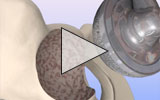Hip Resurfacing
Hip resurfacing, also called surface replacement, is an alternative to total hip replacement (THR) that is appropriate for some patients. This operation preserves more of your natural bone than does a THR.
A traditional total hip replacement involves the removal and replacement of the following with artificial implants:
- arthritic cartilage
- the acetabulum (hip socket)
- the head of the femur (thighbone), known as the femoral head
In a hip resurfacing procedure, your natural femoral head is retained. If you are an active person under the age of 60, it may be appropriate for you to have hip resurfacing. This surgery has advantages and disadvantages, depending on each individual patient.
- Advantages: reduced risk of infection and hip dislocation. It may offer a more stable hip joint than a traditional THR, which is important if you are very active. Resurfacing can also improve the outcome of a revision surgery if you should need one later in life.
- Disadvantages: Possible femur fracture, nerve injury or metal wearing inside the joint could require that you have a revision surgery, most likely a total hip replacement.
Hip resurfacing technology has evolved significantly since the procedure was first introduced in the 1970s. Contemporary surface materials and precision tolerances give improved and promising results in many patients.
Find more detailed information on this condition in the articles and other content below, or find the best hip resurfacing doctor at HSS for your individual condition and insurance.
Step-by-step animation of hip resurfacing procedure
Overview
Hip Resurfacing Success Stories
In the news
